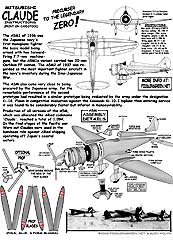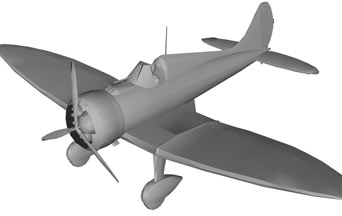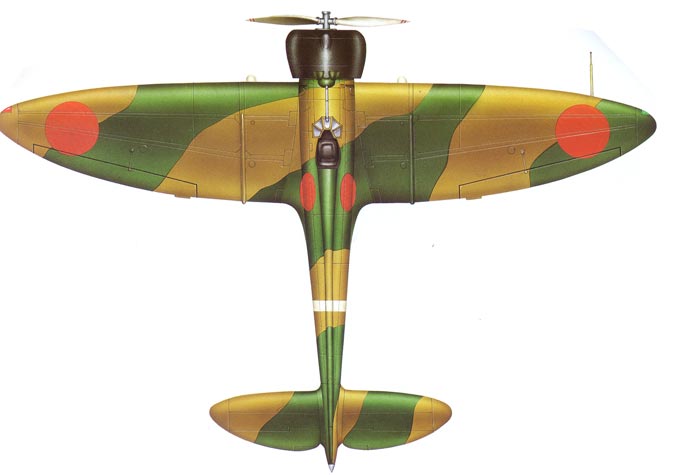


Mitsubishi-Claude - $$5.50
The Mitsubishi A5M a Japanese carrier based fighter aircraft. It was the world's first monoplane shipboard fighter and the direct ancestor of the famous Mitsubishi A6M 'Zero'. The Allied code-name was Claude; the Japanese Navy designation was "Type 96 carrier-based fighter"
Mitsubishi A5M
Japanese Fighter 'Claude'
Mitsubishi A5M 'Claude'


 In February 1934 the Imperial Japanese Navy drew up its specification
for a new single-seat fighter, the requirements including a challenging
maximum speed of 217 mph and a rate of climb that would take it
to 16,405 ft in only 6 minutes 30 seconds.
In February 1934 the Imperial Japanese Navy drew up its specification
for a new single-seat fighter, the requirements including a challenging
maximum speed of 217 mph and a rate of climb that would take it
to 16,405 ft in only 6 minutes 30 seconds.
Mitsubishi took up this challenge with a design team headed by Jiro Horikoshi, later to gain his place in aviation history for the remarkable A6M Zero, working against difficult odds to gain what was seen by Mitsubishi to be a potentially important contract.
All single-seat fighters then in service with the navy were of biplane configuration so the team's monoplane layout was seen as something of a gamble, especially as an earlier monoplane design from Mitsubishi had failed to gain the navy's approval.
Horikoshi's design for the prototype united an inverted gull wing to a narrow section fuselage, the gull wing being chosen to combine a large-diameter propeller with main landing gear units that would be as short as possible.
 The tail unit was conventional, the powerplant
was a 550-hp Nakajima Kotobuki 5 radial engine, and the pilot
was accommodated in an open cockpit directly over the wing.
The tail unit was conventional, the powerplant
was a 550-hp Nakajima Kotobuki 5 radial engine, and the pilot
was accommodated in an open cockpit directly over the wing.
Designated Mitsubishi Ka-14, it was flown for the first time on 4 February 1935 and demonstrated very quickly that it was more than capable of meeting the navy's requirements. In early tests a maximum speed of 280 mph was recorded, and the climb to 16,405 ft was achieved in only 5 minutes 54 seconds. There were, however, aerodynamic shortcomings and so the second prototype was given a conventional cantilever low-wing with split trailing-edge flaps; at the same time a 560-hp Kotobuki 3 engine was installed.
Four other prototypes were completed with varying powerplant's, and it was with the low-wing configuration of the second prototype combined with a 585-hp Kotobuki 2 KAI-1 engine that the Mitsubishi A5M1 was ordered into production as the Navy Type 96 Carrier Fighter Model 1.
The A5M1 of 1936 was the Japanese navy's first monoplane fighter,
the basic model being armed with two forward-firing 7.7-mm (0.303-in)
machine-guns, but the A5M1a variant carried two 20-mm Oerlikon
FF cannon. The A5M2 of 1937 was regarded as the most important
fighter aircraft in the navy's inventory during the Sino-Japanese
War, the performance of the initial A5M2a being improved, by comparison
with the A5M1, by installation of the 610-hp Kotobuki 2-KAI-3
engine; the ensuing generally similar A5M2b differed primarily
by the introduction of more power, with the 640-hp Kotobuki 3,
and early production aircraft had an enclosed cockpit.
 This did
not prove popular with its pilots, and late-production A5M2b fighters
reverted to open cockpit configuration. Under the designation
A5M3 two experimental aircraft were built and these, similar to
earlier open-cockpit production aircraft with a 20-mm cannon firing
through the propeller hub.
This did
not prove popular with its pilots, and late-production A5M2b fighters
reverted to open cockpit configuration. Under the designation
A5M3 two experimental aircraft were built and these, similar to
earlier open-cockpit production aircraft with a 20-mm cannon firing
through the propeller hub.
Final production version was the A5M4 with the uprated Kotobuki 41 radial engine, and under the designation A5M4-K a total of 103 was completed as tandem two seat trainers. At the outbreak of war in the Pacific the A5M4 was then the navy's standard fighter, but this situation was of only short duration for, when confronted by Allied fighter aircraft, the A5M's performance was soon found to be inadequate by the summer of 1942 the type had been relegated to second-line duties.
The A5M had also come very close to being procured by the Japanese
army, for the remarkable performance of the second prototype had
resulted in a similar prototype being evaluated by the army under
the designation Ki-18. Flown in competitive evaluation against
the Kawasaki Ki-10-I biplane then entering service it was found
to be considerably faster but inferior in maneuverability. Two
modified and re-engine Ki-18s were submitted for further testing
under the designation Ki-33, but still lacking in maneuverability
failed to gain an army contract.
Production of all versions of the A5M, which was allocated the
Allied codename 'Claude', reached a total of 1,094, built by Mitsubishi
(791), the Omura Naval Air arsenal (264) and Watanabe (39). In
the final stages of the Pacific war A5M4s and A5M4-Ks were used
in kamikaze role against Allied shipping operating off Japan's
coastal waters .Specification Mitsubishi A5M4 Type: single-seat
ship-based fighter.
 |
Designer Glen's first
A5M Claude beta model |
 |
I guess, although obsolete by that time. Being a 30's design, was used to fight the Russian I-16 Polikov successfully and led to the design of the A6m zero as it's successor (same designer I think). Saburo Sakai's story could offer lots of interesting tidbits. The pretty lines of Japan's designs, and history of powerplant development interesting as well the British radial engine design (Bristol Jupitor) had a major influence it seems on the development of Japan's radials, even though Japan took off from there....there are no existing Claudes, Glen (the designer)
Thank you very much for solving this problem, as always is a pleasure to shop from you!!! Keep on the good work !!!
P.S.Great job with the Mitsubishi ...I hope I'll see more planes and tanks in the future!! Dan
Hello, I was looking at the A5M page and saw that there are two different front views of the A5M with a caption noting the difference. I think I can shed some light on that difference. The top view appears to be of an A6M "Zero" (the gear looks to be retractable). The lower view does look like the A5M, however. Thanks for your time. I have enjoyed building your models, too, and think you have a great site. Keep up the great work. Sincerely, Keoki Gray
|
 |
A5M 'Claudes' in the field
waiting for the skies over China to clear |
 Mitsubishi A5M Front view (note the different wing dihedral arrangement compared to the frontal view below) |
 Mitsubishi A5M side view |
 Mitsubishi A5M Top view |
 |
 Designer Glen sends THIS front view and note that there is a difference between the front view shown in color above.. This shows us that there really isn't a lot of good information about the Mitsubishi A5M. |



